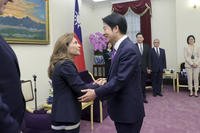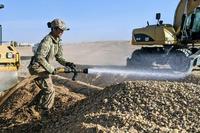The coronavirus pandemic, chaos in the Kabul government and continuing attacks by the Taliban have thrown U.S. and NATO plans to withdraw troops from Afghanistan into confusion.
Army Gen. Austin Scott Miller, commander of U.S. and NATO forces in Afghanistan, said in a statement posted on Twitter Thursday that the military is "making the necessary adjustments to temporarily pause personnel movement into theater" to limit exposure to the virus.
He added that the adjustments will also result in delays to the troop withdrawal schedule, which originally planned to reduce the U.S. troop presence in Afghanistan from about 12,000 to 13,000 currently to 8,600 by this summer.
"In some cases, these measures will necessitate some service members remaining beyond their scheduled departure dates to continue the mission," Miller said.
Related: Allied Forces in Afghanistan Set Up Virus Quarantine Areas; No Confirmed Cases Yet
In addition, a total of about 1,500 service members, civilians and contractors recently arrived in Afghanistan in the past week are being temporarily isolated and screened for COVID-19, he said.
However, NATO Secretary General Jens Stoltenberg indicated Thursday that NATO will continue with its own withdrawal plan to reduce the number of coalition trainers and advisers, plus civilian aides, from 16,000 to 12,000 by this summer, despite uncertainties about the extent of the coronavirus threat in Afghanistan.
"The reality is the coronavirus crisis has implications," Stoltenberg said in a teleconference from NATO headquarters in Brussels.
But he said it is "possible to continue the drawdown and do that in a responsible way," at least initially.
"The situation in Afghanistan is difficult," Stoltenberg said, as the Taliban continue attacks despite agreements with the U.S. last month on troop withdrawals and the opening of negotiations with the Kabul government on an overall peace deal.
He said he is "concerned about political turmoil" in Kabul, where President Ashraf Ghani's legitimacy has been challenged.
Former chief executive Abdullah Abdullah has charged that he was cheated out of the presidency by election fraud and has been setting up a shadow government.
The temporary halt to American troops entering and leaving Afghanistan is expected to last about a month, Miller said, but the spread of coronavirus potentially could alter the current plan.
There have been no reported confirmed cases of the virus among U.S. or coalition troops in Afghanistan thus far, although Pentagon officials said last week that there could be a delay in reporting since tests had to be sent to Landstuhl, Germany, for evaluation.
However, about 21 U.S. and coalition troops are in isolation as a precaution after showing possible symptoms.
In a statement posted to Twitter, Col. Sonny Leggett, a spokesman for the U.S. mission in Afghanistan, said that "protecting the force is our top priority," but "we continue to execute the ordered drawdown to 8600."
The coronavirus crisis has already impacted troops who have returned to the U.S. under the withdrawal plan.
In a precautionary move last Saturday, 300 paratroopers from the 82nd Airborne Division returning to Fort Bragg, North Carolina, from a nine-month deployment to Afghanistan were ordered to quarantine at home or in barracks for at least 14 days.
As of Thursday, Afghanistan's Ministry of Public Health said there were 22 confirmed cases of coronavirus in Afghanistan -- all of them among individuals recently returned from Iraq, Afghanistan's Tolo News agency reported.
-- Richard Sisk can be reached at Richard.Sisk@Military.com.
Read more: More COVID-19 coverage













